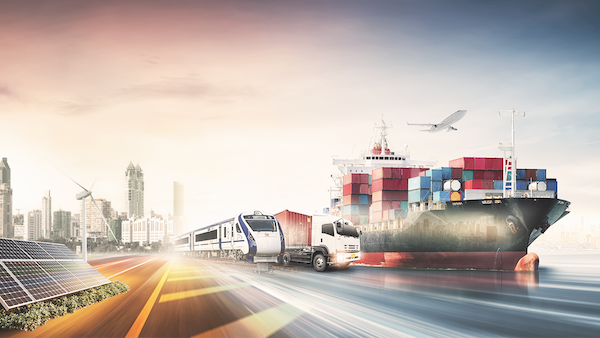India is scripting a new chapter in infrastructure development by not only achieving engineering feats but also establishing the country's leadership in developing world-class infrastructure. Whether it is roads, airports, power plants, or rail networks, these large-scale infrastructure projects are not just limited to development; they are ambitious attempts to build a modern and resilient India.
From desert landscapes transforming into the world's largest renewable energy parks1 to creation of digital highways2 powering the logistics backbone of a $5 trillion economy-in-the-making, India's infrastructure projects are being executed at a scale rarely seen in the world.
Additionally, these are not standalone projects; rather, they are integrated economic engines designed to reduce logistics costs, accelerate urbanisation, and attract manufacturing entities — all while staying aligned with India's climate goals.
For investors, this focus on infrastructure is more than an opportunity. It's a front-row seat to one of the biggest economic transformations of our time. The following 10 mega projects highlight where India is heading and why now is the time to take notice.
1. NICDC Industrial Corridors and Smart Cities
The government is spearheading one of India's most ambitious infrastructure transformations through the development of industrial corridors and smart cities. This project is being implemented by the National Industrial Corridor Development Corporation (NICDC), which is currently overseeing 11 industrial corridor projects encompassing over 32 development nodes across the country.3 These corridors aim to strengthen India's position as a global manufacturing and investment destination by providing state-of-the-art infrastructure, seamless logistics and robust connectivity. The government has also allocated over ₹28,602 crores for 12 smart city projects4 under NICDC, with future-ready, globally competitive industrial ecosystem. These cities will act as economic engines that facilitate job creation, technology transfer, and encourage MSME growth, and high-value production.5
2. PM Gati Shakti Master Plan
The PM Gati Shakti National Master Plan was launched in 2021 to enable efficient infrastructure development in India.6 It is a dedicated platform featuring 44 central ministries and departments as well as 36 states and Union Territories,7 all on a single digital interface, facilitating seamless coordination between ministries and reducing project delays.
In less than three years, data layers from over 1,650 sources8 across ministries has been integrated into Gati Shakti9, creating sops and improving coordination between eight infrastructure ministries and and 15 social sector ministries.10 Its most notable achievement is its role in the planning and execution of pan-India infrastructure projects, enabling optimised alignment of roads, rail, ports and utilities.
Gati Shakti is helping India create seamless multi-modal transport network in India by reducing redundancies and maximising synergies, resulting in greater openness, reliability, and efficiency.
3. Bharatmala Pariyojana Project
The Bharatmala Pariyojana was launched in 2017.11 It is one of India's largest road development programmes, with Phase-I (2017-2022) of the project developing 34,800 km of national highways.12 The project aims to facilitate freight movement and enhance road connectivity in the country.
As of 2024, the National Highways Authority of India (NHAI) has invested ₹4.72 lakh crore13 into the project, and 19,826 km14 have already been constructed. The programme is designed to work in tandem with projects involving economic corridors, logistics parks, and border connectivity. The Bharatmala Pariyojana is also designed to create direct and indirect jobs nationwide.
4. Digital Highways Initiative
The National Highways Authority of India (NHAI) is constructing Digital Highways with dedicated spaces for fibre optics infrastructure. The initiative involves implementing approximately 10,000 km15 of optic fibre cable infrastructure along the National Highways to provide better internet connectivity in rural areas and simplify the rollout of new age 5G/6G technologies across the country.
For the pilot project, the NHAI has identified 1,367 km along the Delhi-Mumbai expressway and 512 km on the Hyderabad-Bengaluru corridor,16 which will feature a three-meter-wide utility corridor to lay fibre optic cables. In the future, these cables are also expected to support technologies such as connected vehicles, real-time traffic updates and digital tolling systems.
5. Western Dedicated Freight Corridor
A part of the Indian Railways Dedicated Freight Corridor project,17 the Western Dedicated Freight Corridor (WDFC) stretches over 1,506 km from Dadri in Uttar Pradesh to Jawaharlal Nehru Port Terminal in Maharashtra.18 The WDFC is a freight-only railway line designed to transport goods. It aims to improve connectivity and decongest the passenger train network by limiting freight trains to their own railway lines. The project is 96.4% operational19 as of May 2025.
6. Delhi-Mumbai Expressway
The Delhi-Mumbai Expressway is one of India's most important national highways. Stretching halfway across the country, the 1,386 km20 eight-lane highway is meant to connect India's economic and political centres. The project is expected to be completed by October 2025,21 reducing the travel time between Delhi and Mumbai by nearly 50%.
7. Airport projects
India's aviation sector has witnessed rapid development in recent years, driven by policy reforms and strategic initiatives such as the UDAN scheme,22 through which 625 UDAN routes have been operationalized, connecting 90 airports (including 2 water aerodromes, and 15 heliports) across India, and the Bharatiya Vayuyan Adhiniyam 2024.23 These efforts are reshaping civil aviation in India by enhancing regional connecti vity and modernising regulatory frameworks.
As part of this broader push—and in response to the rising demand from India's two largest urban hubs—two landmark projects have taken shape: the Noida International Airport (NIA) in Jewar and the Navi Mumbai International Airport (NMI). Both are poised to be pivotal in meeting future air traffic demand and establishing India as a global aviation hub. These projects are expected to be operational by the end of this year. The NIA is overseeing validation flights24 and will be operational by the end of 2025. The NMI, on the other hand, is scheduled to commence commercial operations in August 2025.
8. Khavda Renewable Energy Park
The Khavda Renewable Energy Park is currently being developed by NHPC Limited at an estimated cost of ₹847 crore.25 Located in Khavda, Gujarat, the project will become the world's largest solar park, spanning over 72,600 hectares.26
It is projected to generate about 473 million units of electricity in its first year,27 supporting India's pursuit of clean energy goals. The project is expected to be operational by the end of 2025, emphasising India's dedication to large-scale renewable infrastructure and energy transition.
9. High Speed Rail Projects
India's High-Speed Rail (HSR) projects represent a bold leap toward modernising the country's transport infrastructure and enhancing regional connectivity. Managed by the National High-Speed Rail Corporation Limited (NHSRCL), this project aims to revamp India's railway lines and create bullet train corridors in the country. The first HSR project is 508 km long and is currently under construction between Mumbai and Ahmedabad.28
Once completed, the corridor will support train speeds exceeding 320 km/h—more than twice the speed of India's conventional trains. The project is being developed through a strategic collaboration between the governments of India and Japan, with the Mumbai-Ahmedabad corridor involving an investment of over ₹1.08 lakh crore.29 The HSR project will eventually be expanded to other parts of India, with feasibility being researched between Delhi-Ahmedabad, Delhi-Varanasi, and Varanasi-Howrah.30
10. Vadhavan Port
The recently approved Vadhavan Port Project is a major strategic deep-water port. With an outlay of ₹76,200 crore,31 the Ministry of Ports, Shipping and Waterways aims to complete the project by 2030.
The port will have depths greater than 20 metres,32 allowing it to cater to large shipping types, including ultra-large container vessels. It makes global transhipment and long-range trade routes much easier to handle. The port will also leverage the PM Gati Shakti Master Plan platform and work with other logistics networks, such as intended freight corridors, expressways and waterways.
India's mega infrastructure projects stand as evidence of its commitment to sustainable, technology-driven and inclusive development. This is a unique opportunity for investors to participate in long-gestation, high-impact sectors that align with national priorities.
To learn more about infrastructure landscape of India, check out civil aviation, construction, ports & shipping, railways, and road and highways page or contact us.

